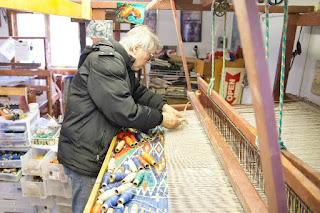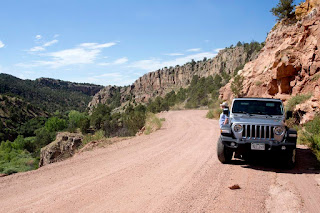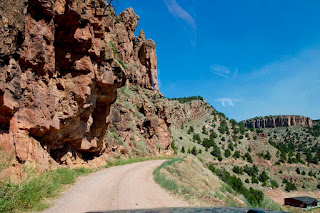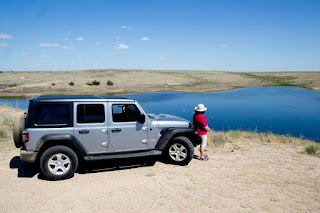Karval is a bucolic little burg out on the Colorado plains.
It's a little less than 20 miles southeast of Punkin Center, as the mountain plover flies. You can get to it by going up CO 71 from Rocky Ford, or on US 24 from Colorado Springs, or the lesser traveled way from La Junta.
We took the lesser traveled way to Karval, then came back down to Ordway via CO 71. From Ordway, we went to Pueblo to visit a couple of the well-known farm markets in the Avondale area just east of Pueblo.
Some of the route from La Junta is paved; much of it is not. All of the road, paved or not, is in very good condition. The unpaved sections have very little washboarding, with one questionable area well-marked with cautionary signs.
We've had a very dry summer. Most of the plains of southeastern Colorado are thoroughly sun-scorched. But the area up north, in Lincoln County, tends to get more rain than down south, and this year has been no exception. Like southeastern Colorado it has been drier up there, but there has still been more rain than here. This became apparent the further north we went.
We left La Junta on CO 109 through Cheraw. Rather than going through Cheraw, we went straight, on CO 30 up to the Holbrook Canal. We veered east on 808/LL to CR 31, then north again. CR 31 runs arrow-straight for several miles till it hits CO 96. We dog-legged over a few hundred yards and picked up CR 31 again. North of CO 96, CR 31 is unpaved. It takes a hard right further on, and then left, becoming CR 2. At some point it also appears to become CR 32 and CR (CO?)109. So, you will see signs at east-west intersections that indicate you are on 31, 32, 2, 32, or 109. In any case, at the intersection with CR F, pavement begins. Keep on for several more miles, and it hangs hard left, becoming CR N before taking a hard right to the north again. After than turn, Karval SWA is just a couple or so miles further on.
This is a great drive, a great look at the eastern plains. Much of it is open range, with cattle wandering aimlessly about.
We did not see much wildife. A few antelope, some red-tailed hawks, a few jack rabbits, some cottontails, and the usual collection of plains songbirds. The trip was during the morning; we arrived at the SWA about mid-day. The best times for wildlife viewing are dawn and dusk. Given the amount of water in the reservoir, and the heat of the day, we'd wager that the critters will be gathered there in the evenings.
Looking south on CR 31, north of CO 96
Open range; cattle have the right of way
One of several nice 'lopes we came across
Karval National Forest
The reservoir is of decent size. It's stocked by state DoW. It's perfect for fishing from a canoe or kayak.
Overlooking the reservoir from the main campground area. There is a well-maintained vault toilet here.
The plains, east of Karval, a few miles west of CO 71.






















































